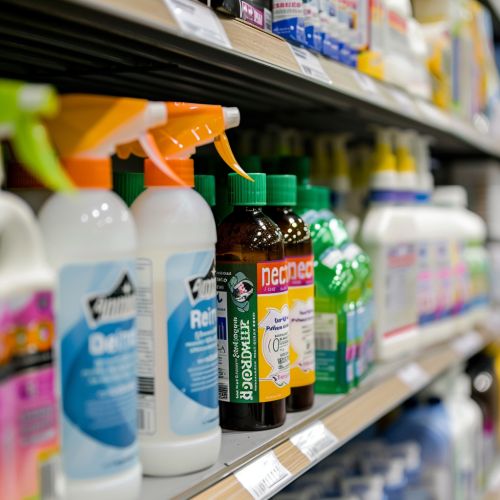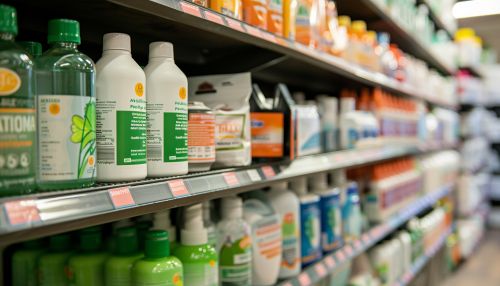Disinfection
Introduction
Disinfection is the process of eliminating or reducing harmful microorganisms, such as bacteria, viruses, and fungi, from inanimate objects and surfaces. This is typically achieved through the use of chemical disinfectants or physical methods, such as heat or radiation. The goal of disinfection is to prevent the spread of infectious diseases and maintain a safe and healthy environment.
Types of Disinfectants
There are several types of disinfectants used in various settings, each with its own strengths and weaknesses. These include, but are not limited to, alcohols, aldehydes, phenolics, quaternary ammonium compounds, and oxidizing agents.


Alcohols
Alcohols, such as ethanol and isopropanol, are commonly used disinfectants due to their broad-spectrum antimicrobial activity. They work by denaturing proteins and dissolving lipids, leading to cell death. However, alcohols are not effective against bacterial spores and certain viruses.
Aldehydes
Aldehydes, such as formaldehyde and glutaraldehyde, are highly effective disinfectants and sterilants. They work by cross-linking and denaturing proteins and nucleic acids, leading to microbial death. However, they are potentially carcinogenic and can cause skin and respiratory irritation.
Phenolics
Phenolic disinfectants, such as phenol and cresols, are effective against a wide range of microorganisms, including Mycobacterium tuberculosis. They work by disrupting cell walls and precipitating proteins. However, they can be corrosive and irritating to skin.
Quaternary Ammonium Compounds
Quaternary ammonium compounds, or quats, are widely used in household and industrial disinfectants. They are effective against a broad range of microorganisms and work by disrupting cell membranes and denaturing proteins. However, they are not effective against bacterial spores and certain types of viruses.
Oxidizing Agents
Oxidizing agents, such as hydrogen peroxide and chlorine compounds, are powerful disinfectants that work by oxidizing cellular components, leading to microbial death. They are effective against a wide range of microorganisms, including bacterial spores and viruses. However, they can be corrosive and can cause skin and eye irritation.
Methods of Disinfection
Disinfection can be achieved through various methods, depending on the nature of the object or surface to be disinfected, the type of microorganisms present, and the desired level of disinfection.
Chemical Disinfection
Chemical disinfection involves the use of chemical disinfectants to kill or inactivate microorganisms. The effectiveness of chemical disinfection depends on several factors, including the concentration and contact time of the disinfectant, the presence of organic matter, and the resistance of the microorganisms.
Physical Disinfection
Physical disinfection involves the use of physical methods, such as heat, radiation, or filtration, to kill or inactivate microorganisms. Heat is one of the most common and effective methods of disinfection and can be applied through moist heat (autoclaving) or dry heat. Radiation, such as ultraviolet (UV) light, can also be used to disinfect air, water, and surfaces. Filtration is a method of removing microorganisms from air or liquids.
Mechanical Disinfection
Mechanical disinfection involves the physical removal of microorganisms from surfaces through cleaning processes. This can involve the use of detergents, scrubbing, and rinsing. While mechanical disinfection does not kill microorganisms, it can significantly reduce their numbers and is often used in combination with chemical or physical disinfection.
Applications of Disinfection
Disinfection plays a crucial role in various sectors, including healthcare, food and beverage industry, water treatment, and household settings.
Healthcare
In healthcare settings, disinfection is essential to prevent the spread of infectious diseases. This includes the disinfection of medical instruments, surfaces, and the hands of healthcare workers.
Food and Beverage Industry
In the food and beverage industry, disinfection is used to ensure the safety and quality of food products. This includes the disinfection of food processing equipment, surfaces, and water used in food preparation.
Water Treatment
In water treatment, disinfection is used to kill or inactivate microorganisms in drinking water and wastewater, preventing the spread of waterborne diseases.
Household Settings
In household settings, disinfection is used to maintain a clean and healthy environment. This includes the disinfection of surfaces, utensils, and personal hygiene products.
Safety and Environmental Considerations
While disinfection is essential for maintaining health and safety, it also has potential safety and environmental implications. Many disinfectants are toxic or corrosive and can cause harm to humans and animals if improperly used or disposed of. Furthermore, the overuse or misuse of disinfectants can contribute to the development of antimicrobial resistance, a significant public health concern.
